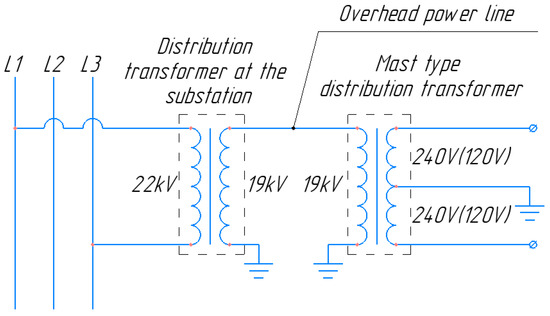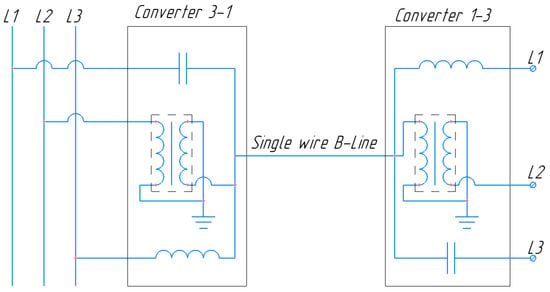You're using an outdated browser. Please upgrade to a modern browser for the best experience.
Please note this is a comparison between Version 1 by Vadim Bolshev and Version 3 by Dean Liu.
A single-wire power transmission is an option for reducing the capital cost of power line construction by utilizing fewer conductors and fittings and lighter power transmission towers while lowering operational expenses.
- single-wire transmission
- resonant power transmission
- remote settlement supply
1. Introduction
Electricity supply, as well as heat supply, and the provision of other forms of resources are one of the foundations of efficient agriculture, and the aspect of its development is particularly important. However, due to a reduction in the number of people living in rural settlements, a large number of power lines have emerged, supplying a small load with a considerable length of these lines. At the same time, a significant portion of consumers, particularly garden societies, holiday villages, country houses, and some industrial facilities, are seasonal in nature and practically do not consume electricity for a part of the year. This ultimately results in an increase in the cost of electricity since the maintenance of power lines in most cases is carried out anyway. In many countries, in order to lessen social tension, these costs are included in the tariff for enterprises according to the philosophy of cross-subsidization, which, in turn, leads to an increase in higher product costs and a decrease in competitiveness. Therefore, studies (solutions) aimed at solving the problems of reducing the cost of providing electricity to consumers that are remotely located from power centers and who receive a small load are pertinent. At the same time, these research and development methods should deliver the required efficiency, including highly reliable power supplies and adherence to power quality criteria [1]. One such solution is distributed generation based on renewable energy sources (RESs), which is the most popular among the scientific and political community. However, as practice shows [2], it is frequently not possible to resolve the problem using simply renewable energy sources, hence necessitating the development of strategies to lower the costs of constructing and maintaining electrical networks.
According to the calculated data, the cost of constructing an electrical transmission line (ETL) amounts to a large sum. So, in the Russian Federation, the cost of constructing a 10 kV ETL is currently about RUB 2–3 million (USD 27–41 thousand) per kilometer [3], while in the USA, it is USD 45 thousand per mile [4]. With a load power of several kW on this line, these costs may not pay off, although they must be borne by the power grid organization for social reasons [5]. One option for reducing the cost of construction and the operation of electrical transmission lines is the use of single-wire transmission lines. These lines make it possible to reduce capital costs by utilizing fewer conductors and fittings and lighter power transmission towers while lowering operational expenses.
The conducted information search revealed four alternatives for single-wire power transmission systems: a single-wire earth return (SWER) system, single-wire balanced line (B-Line), resonant wireless power transmission (SWPT) system using an additional connecting line between high-voltage transformers, and resonant single-wire power transmission line. Each of the systems has its own advantages and disadvantages as well as its own scope. However, for the transmission of electrical energy to consumers that are remotely located from the centralized power supply system, the most suitable options are SWER systems and systems based on resonant technology proposed at the All-Russian Research Institute for Electrification of Agriculture.
2 Single-Phase Earth Return Power Transmission System
The SWER (single-wire earth return) system is the most widely used and researched single-wire power transmission line. In such a line, electricity is delivered through a single conductor while Earth is used as the return conductor (see Figure 1). SWER lines are used to supply electricity to distant consumers at the expense of a lower price and are primarily distributed in the rural areas of Australia and New Zealand in order to supply small loads that are dispersed over a large area [6]. Due to the low cost of power lines, this system has also become widespread in the Canadian province of Saskatchewan, Brazil, Africa, and parts of the Upper Midwest and Alaska in the United States of America [7].
 It is important to emphasize SWER’s low cost when discussing its benefits. Capital costs can be approximately 50% of an equivalent two-wire single-phase line [8][9][8,9]. Lower costs are associated with savings on wires, fewer fittings on poles, and fewer switching and protection devices. Additionally, SWER lines are simpler to design, enabling quicker construction. Thus, it is known that the distance between power transmission towers is usually determined not by the strength of the wire but by the wire overlap problem caused by the wind. In this regard, reducing the distance between supports and increasing the distance between wires inevitably increase the capital and operating costs of power transmission lines. In turn, the use of one wire in an electrical transmission line makes it possible to level the problem of wire overlaps, and ETL should be designed only with respect to the strength of the wires themselves. While traditional two-wire or three-wire distribution lines require 7 towers per kilometer, SWER lines only need 2.5 towers. However, it must be taken into account that an isolation transformer is required for the SWER system, which makes the deployment of the SWER system economically justified only for distances less than 3 km long.
However, SWER systems have a number of critical drawbacks [10]. First, the transmitted power is limited by a ground resistance of roughly 1 ohm, which permits the use of currents up to 8 A. Second, electrical safety in SWER systems is inferior compared to conventional two-wire and three-wire systems. A step voltage arises near powerful SWER grounding, which can be dangerous for people and animals. Therefore, the system is designed in such a way that the step voltage in the soil does not exceed 20 V/m. Because SWER lines cause the electrical corrosion of urban infrastructure, their usage in cities is prohibited. Additionally, not all instances of wire breaks in SWER systems may be detected by ordinary measures of protection, and in areas with large forests, there may be a possibility of forest fires. Therefore, in many countries, including the Russian Federation, the construction of SWER systems is against the law. Finally, in article [11], a comparison of conventional power transmission systems was carried out, during which the authors showed that SWER systems suffer from additional energy losses brought on by the appearance of reactive power. These losses are influenced by the resistance of the Earth used as a second conductor; that is, the length of the transmission line is inhibited.
It is important to emphasize SWER’s low cost when discussing its benefits. Capital costs can be approximately 50% of an equivalent two-wire single-phase line [8][9][8,9]. Lower costs are associated with savings on wires, fewer fittings on poles, and fewer switching and protection devices. Additionally, SWER lines are simpler to design, enabling quicker construction. Thus, it is known that the distance between power transmission towers is usually determined not by the strength of the wire but by the wire overlap problem caused by the wind. In this regard, reducing the distance between supports and increasing the distance between wires inevitably increase the capital and operating costs of power transmission lines. In turn, the use of one wire in an electrical transmission line makes it possible to level the problem of wire overlaps, and ETL should be designed only with respect to the strength of the wires themselves. While traditional two-wire or three-wire distribution lines require 7 towers per kilometer, SWER lines only need 2.5 towers. However, it must be taken into account that an isolation transformer is required for the SWER system, which makes the deployment of the SWER system economically justified only for distances less than 3 km long.
However, SWER systems have a number of critical drawbacks [10]. First, the transmitted power is limited by a ground resistance of roughly 1 ohm, which permits the use of currents up to 8 A. Second, electrical safety in SWER systems is inferior compared to conventional two-wire and three-wire systems. A step voltage arises near powerful SWER grounding, which can be dangerous for people and animals. Therefore, the system is designed in such a way that the step voltage in the soil does not exceed 20 V/m. Because SWER lines cause the electrical corrosion of urban infrastructure, their usage in cities is prohibited. Additionally, not all instances of wire breaks in SWER systems may be detected by ordinary measures of protection, and in areas with large forests, there may be a possibility of forest fires. Therefore, in many countries, including the Russian Federation, the construction of SWER systems is against the law. Finally, in article [11], a comparison of conventional power transmission systems was carried out, during which the authors showed that SWER systems suffer from additional energy losses brought on by the appearance of reactive power. These losses are influenced by the resistance of the Earth used as a second conductor; that is, the length of the transmission line is inhibited.
 Despite the fact that the researchers of the B-Line system assert that the power transmission system they have developed can significantly reduce the cost of power transmission line construction by using one wire instead of three, this statement is not underpinned by trustworthy calculations. The assertion is most likely not justified because of the use of additional equipment (converters) and increased wire cross-section.
Despite the fact that the researchers of the B-Line system assert that the power transmission system they have developed can significantly reduce the cost of power transmission line construction by using one wire instead of three, this statement is not underpinned by trustworthy calculations. The assertion is most likely not justified because of the use of additional equipment (converters) and increased wire cross-section.

Figure 1. Schematic diagram of a single-wire earth return line.
3. Single-Wire Balanced Line
Michael Bank and colleagues proposed the use of a single-wire balanced line (the B-Line) to address the “imbalance” issue with respect to SWER systems [12][13][12,13]. The authors developed a method for combining two wires into one using two converters (phase shifters), which can be performed by transformers with opposite windings. The first converter changes the phases of two wires in such a way that the “common” one is obtained, and it transmits electricity via a single-wire line to the second converter, which already decomposes the “common phase” into two phases with the desired shift. The author proposes using the same principle for a three-phase system [13][14][13,14]. The block diagram of the B-Line system is depicted in Figure 2.
Figure 2. Schematic diagram of a three-phase single-wire B-Line.
